|
Monday, June 7, 2010
Progress Notes
Recently, we received as a donation a very rare and historical portable printing press made in 1841 which was owned by James Pinkney Wright, the very well known Tuscumbia newspaper publisher (photo 01).
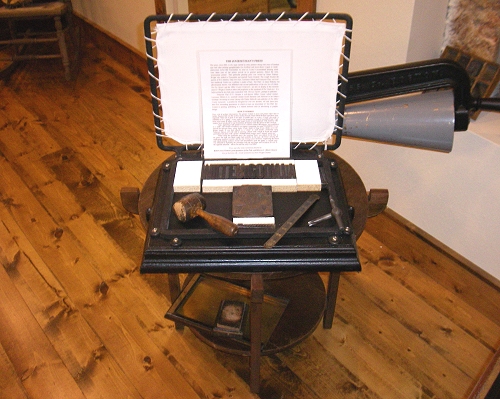
01 James Pinkney Wright Press The press was brought to us by former Tuscumbia resident, Robert Clemens, who is the great grandson of James Pinkney Wright. Here is a photo of Robert accompanied by his sister Annette and Rebecca his wife taken the day they brought us the press (photo 02):
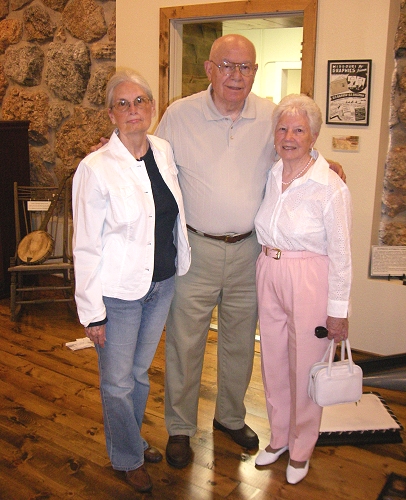
02 Annette Clemens Vaughan, Robert and Rebecca Clemens Robert told me that James Pinkney would carry the press with him on periodical steamboat trips on the Osage River to visit various river towns for the purpose of printing cards, documents or fliers for merchants.
Below Robert explains more about the history of the press as used by his great grandfather, James Pinkney Wright:
The Journeyman’s Press
This Press, Circa 1841, is of a type carried by early printers…along with cases of handset type and other printing paraphernalia…via riverboat and horse drawn wagon to small, midwestern towns like Tuscumbia. As soon as a town’s accumulated printing needs were taken care of, the printer moved on to greener pastures. Hence the term, “journeyman printer.” This particular printing press was owned by James Pinkney Wright who settled in Tuscumbia and married Carrie Fendorf. The couple became the parents of five children. Only two boys, Lawrence Alfred and Tennyson Clay, survived into adulthood. Carrie was a milliner, a maker of hats. “Jim Pink,” as James Pinkney was affectionately known, was affiliated with several publications of the era, two of which, The Eye Opener and The Miller County Vindicator, are also on display in this museum. James P. Wright is listed as editor and proprietor on the masthead of The Vindicator. It is believed that he also had some connection with The Eye Opener, perhaps as publisher.
Tennyson Clay Wright (T.C.) became a well known Miller County school teacher. Lawrence Alfred (L.A.) married Carmen Ercell Bassman and followed in his father’s footsteps, becoming co-owner (along with Walter Stillwell) and publisher of The Miller County Autogram, a position he occupied for over two decades. All told, there have been five succeeding generations in which at least one descendant of “Jim Pink” has worked in printing, publishing or a related business, such as advertising or graphic design.
How It Worked
First, a bit of archaic information: the printer worked in picas and points rather than in inches, because that was the system used in Europe, from which the first type faces were imported. There are 6 picas to an inch, 12 points (pts) to a pica. A brass ‘pica pole’ is exhibited as is a ‘galley’ tray used for the temporary storage of assembled type. Type faces were made of either wood (the larger faces) or lead hardened with antimony (the smaller faces…produced in type foundries); all were handset until the advent of the Linotype.
Type, appearing to the printer as if in a mirror rotated 180 degrees, was assembled in a ‘stick,’ one version of which is on display containing the name CLEMENS. It was spaced out between lines, using ‘leads’ (2 pts. thick) or slugs (6 pts. thick) cut to the proper length. It was then placed in a ‘chase’ (a steel frame), positioned using ‘furniture’ (pieces of wood used as spacing), planed with a block of wood and mallet, and locked into place with ‘quoins’ (toothed metal wedges) and T shaped ‘quoin key.’
When using this particular press, the resulting ‘form’ was placed on the bed of the press, the type was inked, paper laid carefully on the type, the frame carrying the cushioning material lowered, and the arm swung across the form, impressing the raised and inked printing surfaces (words and illustrations) upon the paper. A second copy was obtained by repeating the procedure with ink and paper and swinging the arm in the opposite direction…and so on until the order was filled.
Press and other items mentioned donated by:
Robert Avery Clemens, great grandson of Jim Pink, and Rebecca C. (Etter) Clemens
Also see the book “Life…A Trail of Memories” by Doris (Wright) Clemens
Here are photos of some of the press accessories mentioned above by Robert in his narrative (photos 03 and 04):
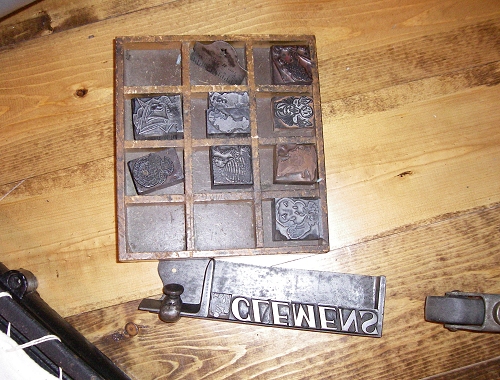
03 Dies and Layout Tools
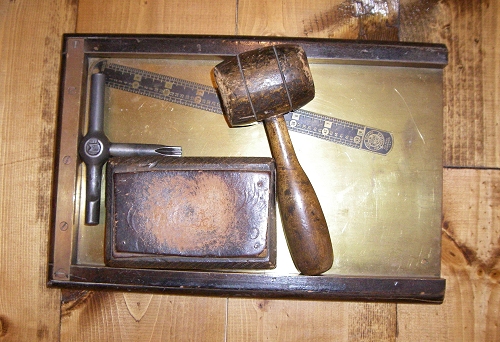
04 Layout Tray and Pica Ruler Also, here are photos of hard bound editions of the 1884 Miller County Vindicator and the 1891 The Eye Opener which were given us by Robert having belonged to his great grandfather, James Pinkney (photos 05 and 06):
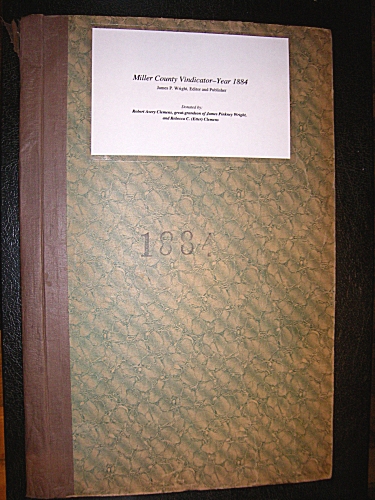
05 Miller County Vindicator - 1884
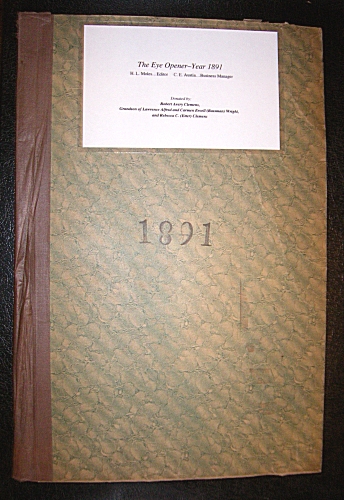
06 The Eye Opener - 1891 Robert’s Wright family heritage goes back to the original Wright to come to Miller County, James Lawrence Wright (photo 07).
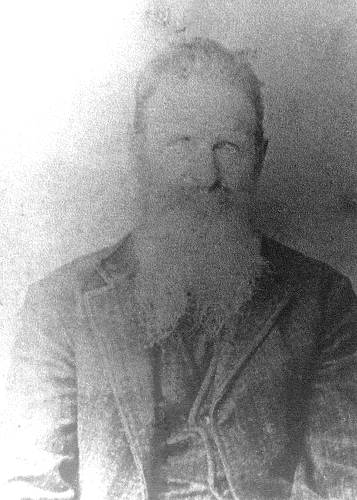
07 James Lawrence Wright - 1818-1896 James Pinkney Wright, Robert’s great grandfather, was a son of James Lawrence Wright (photo 08).
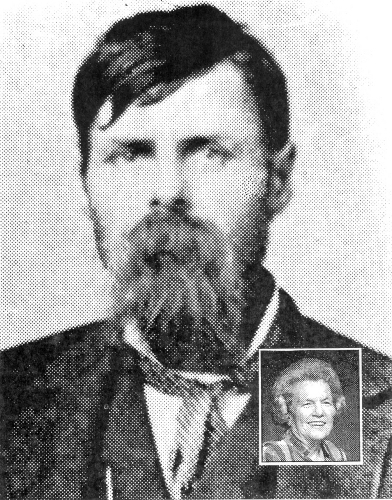
08 James Pinkney Wright - Inset: Granddaughter Doris Wright Clemens Lawrence Alfred Wright, an early publisher of the Miller County Autogram, was Robert’s grandfather (photo 09).
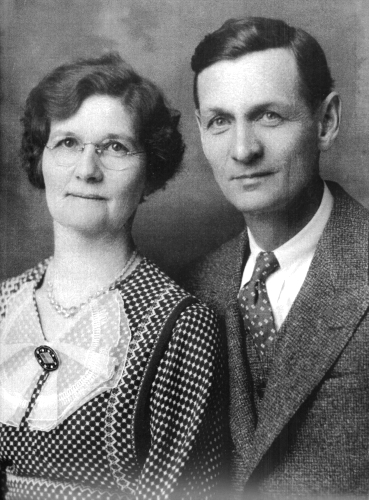
09 Lawrence Alfred and Carmen Ercel Bassman Wright The following biography of Lawrence Wright given me by Robert is very informative:
A Short Biography of
Lawrence Alfred Wright
From
History of Missouri, Volume III
Published by: The American Historical Society…1930
Lawrence A. Wright is business manager and one of the publishers and editors of the Miller County Autogram at Tuscumbia. Most of his life has been spent in or around a newspaper printing office. His father, James Pinkney Wright, was a veteran publisher. Lawrence A. Wright may be said to have begun his training for the business in his father’s shop when he set up a line of type commemorating his anniversary. The line of type said: “I am six years old today,” and to this he signed his name.
The Miller County Autogram is one of the old and influential newspapers in this section of the state. It was first published at Aurora Springs, March 25, 1883, and on July 31 of the same year the place of publication was transferred to Tuscumbia, which has been its home every since. The first publishers were B.W. Marcy and Mord McBride, but a few months after publication was started Mr. McBride acquired full interest and continued to publish the paper at Tuscumbia until the year 1910, when he sold to W.E. Martin and W.M. Bear (photo 10).
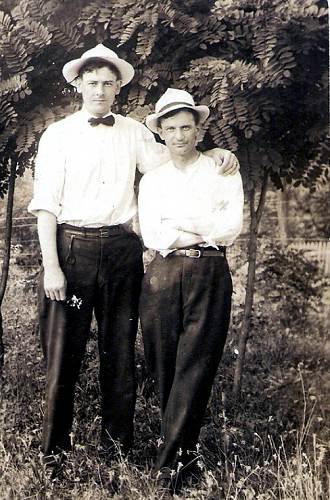
10 Will Bear and Ed Clark A few years later Mr. Martin bought Mr. Bear’s interest, then he sold to E.P. Clark a one half interest (photo 11).
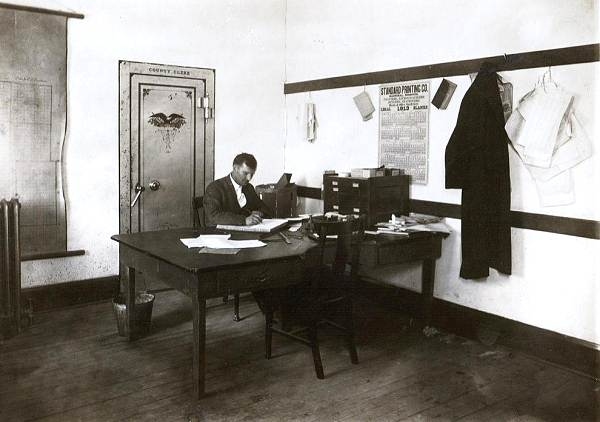
11 Edward P. Clark - 1913 In the spring of 1919 Mr. Wright and his partner, Walter S. Stillwell, acquired the paper (photo 12).
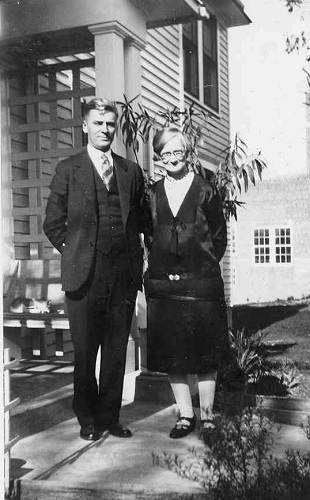
12 Walter and Lydia Fendorf Stillwell During the past nine years the circulation of the paper has grown from 700 to 2,400. The Autogram is a seven column, eight page weekly, and it has measured up to all the essential qualifications of a good country town newspaper, publishing a full quota of clean news, affording exceptional advertising facilities, and also containing various popular special features.
Lawrence A. Wright was born at Tuscumbia, February 9, 1886, son of James P. and Carrie Minnie (Fendorf) Wright, and grandson of James L. Wright. James L. Wright served as a lieutenant in the Union army following the Civil war. The Wright family settled in Miller County about 1856.
James L. Wright built a water mill three miles north of Tuscumbia, a property now known as Wright’s Spring. The water from this spring supplied the power for the mill. For a number of years it operated a carding machine and corn burrs (photo 13).
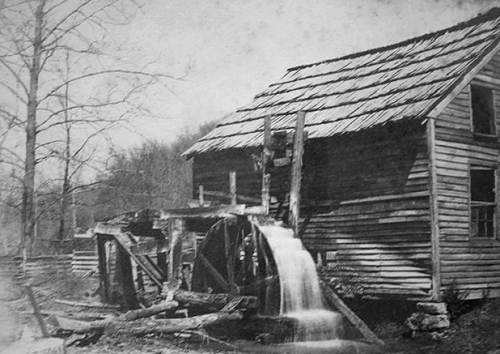
13 Wright Grist Mill at Wright Spring on the Little Saline Creek James P. Wright was born on Bois Bruhle Creek in Cole County, Missouri, in 1850, and died June 9, 1922. He was educated in rural schools, taught school for a time, and was always known as a reader and thinker and a man of fine citizenship and high moral courage. He was an elder in the Tuscumbia Christian Church. In the late seventies, he with J.H.D. Thompson, began the publication of the Gospel Messenger, a religious paper; in 1880 it was changed to a weekly newspaper; under the name of the Miller County Vindicator (photo 14).
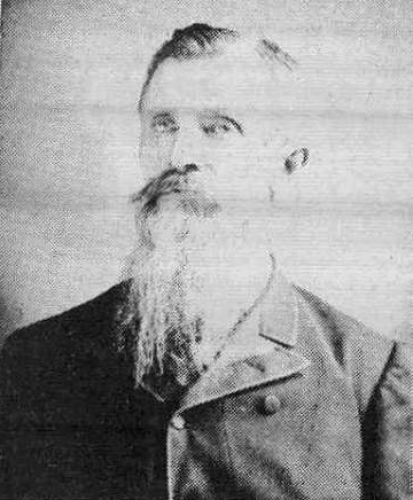
14 Reverend Josiah Henry Dockery Thompson Later Mr. Wright acquired full control and changed the name of the paper to the Eye Opener, and in 1896 he sold the paper to Warren M. Barr. He also published the Western Preacher, a religious monthly, in partnership with H. Drennan, for a number of years. James P. Wright was an original member of the Good Templars organization.
Both he and his wife were outspoken in the temperance cause. His wife, Carrie Minnie Fendorf, who is still living, was born in Pennsylvania, of German ancestry. As a girl she was a German Lutheran and since her marriage has been affiliated with the Christian Church. While both parents were active members of this denomination their home was always open and a welcome extended to ministers of every creed. James P. Wright would give his last dollar to help struggling ministers. He had little desire to accumulate wealth and he paid many security debts. His wife came to Missouri with her parents while she was a small child. Her mother died a few years later, and then she, at the age of fourteen, went to Jefferson City to seek a livelihood. She became a dressmaker, and in the early days she made frocks for a number of families of prominent politically and socially, including the families of B. Gratz Brown and Joseph W. Mcclurg, former governors of Missouri. Even now she carries on a millinery business at Tuscumbia. The story is told that one of her customers, disliking her stand on the temperance question, canceled an order for a dress. She and her husband were married in 1882, and of their five children the two living are Lawrence A. and Tennyson C. (photo 15).
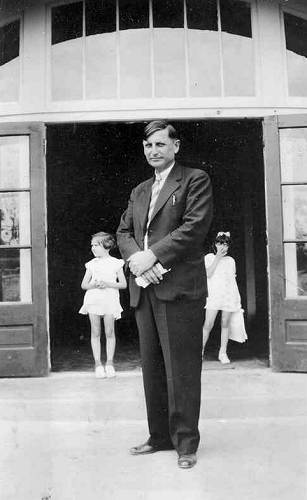
15 Tennyson Clay Wright Two others, Chester R. and Mary Isabel, died in childhood, while the other daughter, Grace M., died at the age of twenty one.
Lawrence A. Wright grew up in Tuscumbia, attended the public schools there, and has found many opportunities to express his talents and industry in local affairs. During the World War, while both the cashier and assistant cashier were in service, he took their places in the Bank of Tuscumbia. He was director of banks and treasurer of the United War Work funds for Miller County, and during the various drives all funds were over subscribed. For his services he was given an honor medal by the Government. He is a member of the National Editorial Association and the Missouri Press Association, and is on the Board of Deacons of the Christian Church. He is a Democrat in politics and was twice drafted by his party as a candidate for office. While the county is substantially Republican, he was defeated in 1912 by only seventeen votes for county Treasurer and by only one vote for county assessor in 1914.
He married Miss Carmen Ercell Bassman in April, 1909, and they have four children… Dorothy Hope, Doris Nadine, Gerald Vance and Lloyd Alfred.
Doris Nadine, one of Lawrence and Ercell’s daughters, was the mother of Robert Clemens (photo 16).
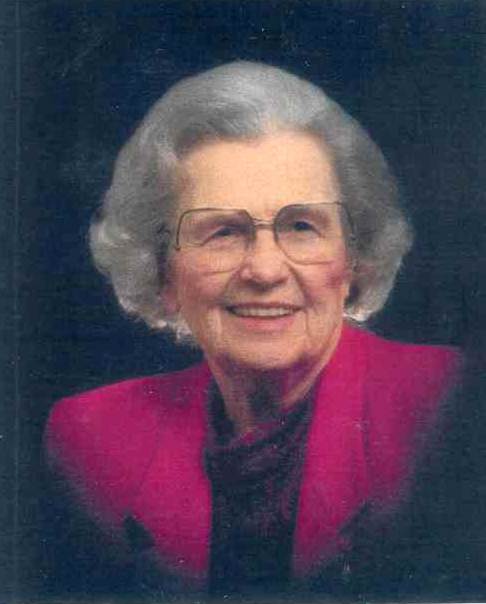
16 Doris Wright Clemens She wrote a book a number of years ago entitled “Life…A Trail of Memories” which was a summary of the memories of her life in Tuscumbia, Missouri as a child growing up. I copied extensively from it in a previous Progress Notes about Hauenstein’s General Store.
Robert told me he helped her edit the book and get it published.
James Pinkney Wright, Robert’s great grandfather, was exceptionally respected by his peers in the early journalistic endeavors in Miller County. The following paragraph about him was taken from a newspaper article published in the Olean Miller County News in 1899:
“The Western Preacher is a 16-page religious monthly published at Tuscumbia by James P. Wright and edited by Elder H. Crennen, of Seymour, Mo. Mr. Wright is one of the oldest printers in the county and has probably been in the business longer continuously than any man now engaged in the printing business in Miller County.”
In the same newspaper article another paragraph about James Pinkney was written:
“In 1872 J.P. Wright and J.H.D. Thomson founded The Gospel Proclamation, a religious monthly. This paper continued for several years—up until 1874—when Mr. Wright bought the interest of Mr. Thomson and made the paper a Republican paper and issued it weekly. This was The Miller County Vindicator. This paper suspended publication in 1888 and a few months later with this outfit D.F. Thomson established The Eye-Opener, of which The Osage Valley Record is the successor (photo 17).”
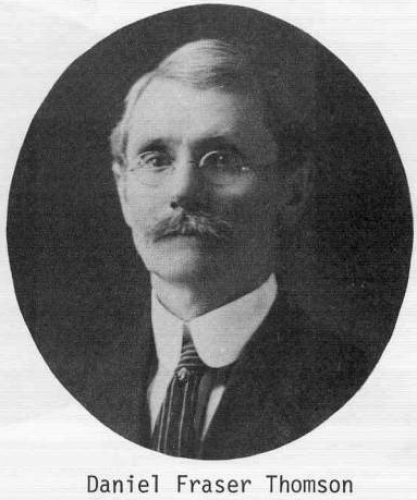
17 Daniel Fraser Thomson You can read more about the early history of Miller County newspapers on our own website.
James Pinkney was a devoutly religious person. He was one of the charter members of the Tuscumbia Christian Church. The Fiftieth Anniversary program bulletin published in 1939 has the following tribute to him and his wife, Carrie (photos 18 and 19).
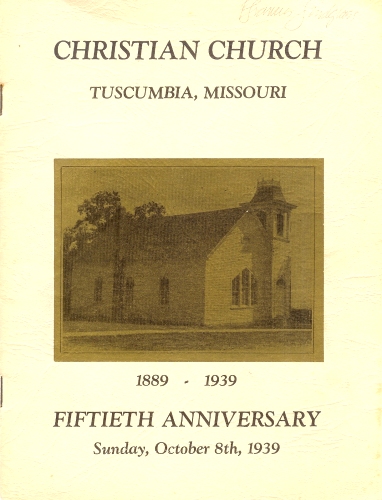
18 Christian Church Fiftieth Anniversary
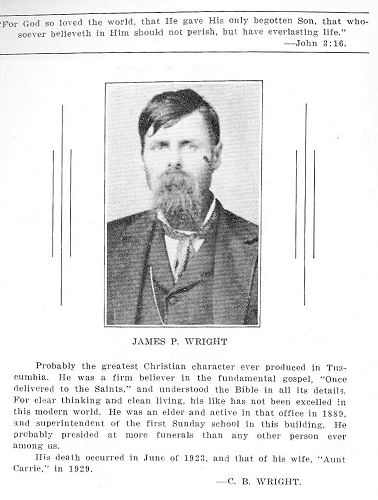
19 James P. Wright
Click image for larger viewThe James Pinckney Wright family has had four generations who have worked in the printing and/or newspaper profession: James Pinckney Wright, Lawrence Wright, Robert Clemens, and now Robert informs me his son is also in the business.
A well known Wright cousin of Robert’s who also was in the printing profession was James Robert Wright of Tuscumbia. Here is a photo of James Robert with his wife Wanda Warren Wright (Wanda is a member of our Miller County Historical Society Board) (photo 20).
AndJamesRobertWright.jpg)
20 Wanda (Warren) and James Robert Wright James Robert’s great grandfather, Hiram Wright was a brother to James Lawrence Wright, who was Robert’s great great grandfather. Here is a photo of the printing press James Robert used to print cards, leaflets and posters (photo 21):
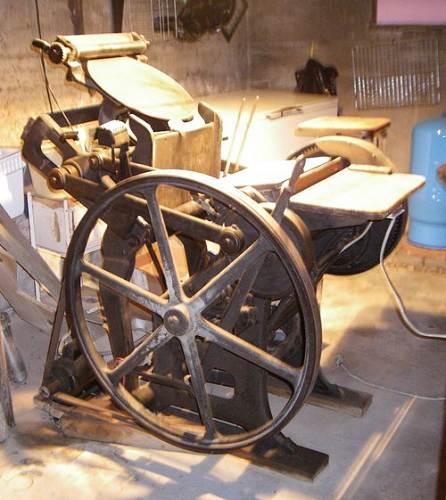
21 Cleveland and Price Co. Printer James Robert Wright You can read more about this press as well as the James Robert Wright family on our website.
Wallace Vernon of Eldon, owner and publisher of six weekly newspapers in the area, told me recently that back in the 1960’s both Robert Clemens and James Robert Wright were working for him at the Vernon Publishing Company’s office in Eldon. And Robert told me that even before working for Wallace he and James Robert worked together for awhile in Tuscumbia at the old Autogram newspaper owned at that time by Jac Zimmerman. Then after Wallace bought the Autogram from Jac, Robert and James went up to Eldon to work for Wallace.
So in summary, it is a wonderful gift to the museum by Robert Clemens of his great grandfather James Pinckney Wright’s old press and providing for us the history of the press and the Wright family’s contribution to the profession of journalism in Miller County.
Last week the William’s Cemetery Association met in Iberia at the fellowship hall of the Christian Church for its annual Memorial Day weekend meeting. Don Pemberton of Cape Girardeau was the speaker for the occasion (photo 22).
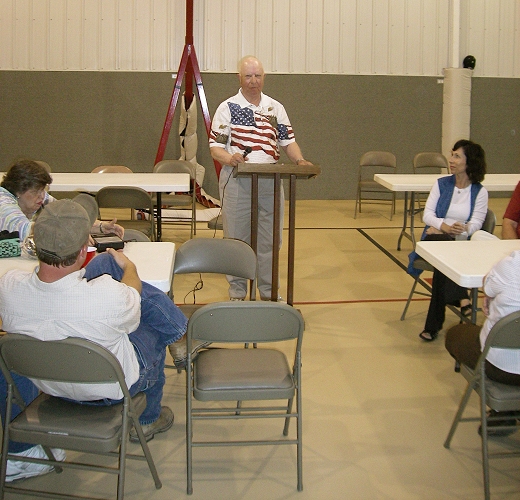
22 Don Pemberton Don, who was born and raised on a farm next to where is located the Williams’ Cemetery, was a graduate of the Iberia Academy. Early on after serving in the U.S. Armed forces during WWII he settled in Cape Girardeau where he operated a very successful farming and grain storage business. As a long time member of the Rotary Club there Don was friends with members of the Limbaugh family, Rush Limbaugh 1st and his son Rush Limbaugh 2nd. Rush Limbaugh 3rd, who was a classmate of Don’s daughter, was an occasional visitor in his home. Don told me that he thought both the elder Rush Limbaugh 1st and his son Rush Limbaugh 2nd were two of the most intelligent and well read men he had known. Some forty five years ago, Rush Limbaugh 2nd presented an essay to the Rotary Club which so impressed Don that he never forgot it (photo 22a).
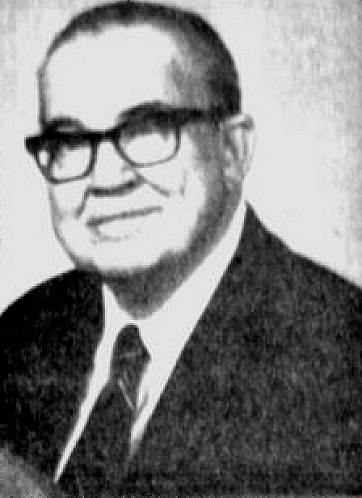
22a Rush Hudson Limbaugh, Jr. Don thought the essay was so important that it should be shared and made known to a wider audience than those members of the Rotary Club in Cape Girardeau so many years ago. So Don asked permission from the family to receive a copy of the speech written by Rush Limbaugh 2nd to present to the members of the Williams Cemetery Association. The essay written by Rush Limbaugh 2nd is very appropriate for a Memorial Day weekend because it remembers and honors our first American heroes, the signers of the Declaration of Independence. Many people do not know that the signers of the Declaration of Independence paid dearly for their courage and bravery to initiate the separation of the 13 American Colonies from British subjugation and control.
The title of the essay is:
“What happened to the 56 men who signed the Declaration of Independence in 1776.”
You can learn more about the life of Rush Limbaugh Jr. from his obituary which was sent me by our website consultant, David Statler (photo 22b).
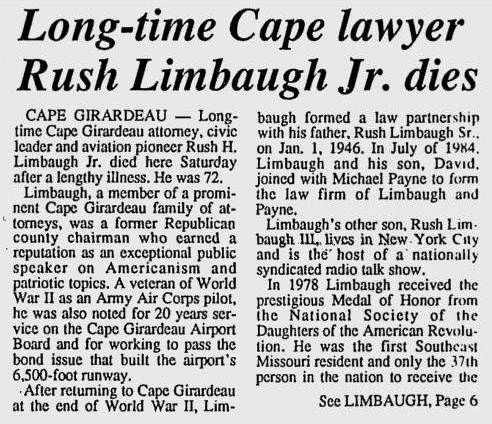
22b Rush Hudson Limbaugh, Jr. Obituary
As found in the Southeast Missourian Newspaper, Cape Girardeau, MO
Click image above to view complete obituary articleDon has done some original research of his own to amplify the original essay by Mr. Limbaugh as he describes in his introduction to the presentation.
You can read it by clicking on this attachment (photo 23):
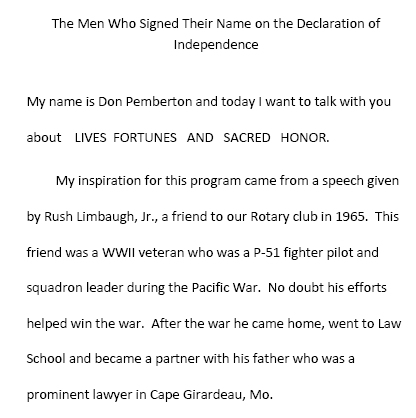
23 The Men Who Signed Their Name on the Declaration of Independence
Click image to read the full PDF document
Last winter Nancy Thompson, our museum director, asked me why Bill Hartack, the famous horse racing jockey, would have been buried in the Iberia Cemetery. I had not heard anything about that and I was curious myself. So I went over to the cemetery a day or two after a snow fall and sure enough, a large beautiful tombstone was present on the west side of the cemetery with Hartack’s name boldly engraved (photo 25).
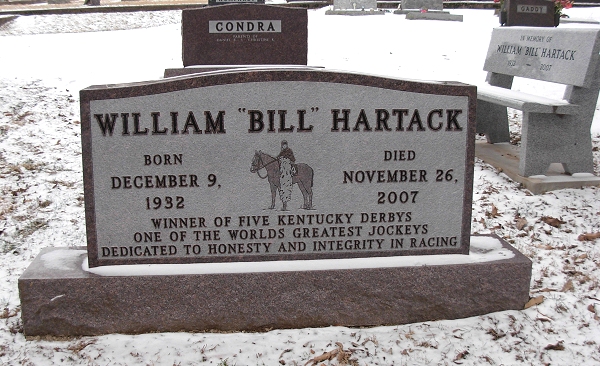
25 William Hartack Tombstone I was so curious about how it came to be that Bill Hartack would be buried in Iberia, Missouri that I did some research on the internet and found the story:
“The late Hall of Famer and 5-time Kentucky Derby winning jockey Bill Hartack will be buried on December 6 in Iberia, Missouri. Funeral service will be held at Iberia Cemetery at 2:00 p.m. A memorial service will follow on December 10 2:00 pm at Grace Lutheran Church and Learning Center at 254 Curtiss Parkway in Miami Springs, Florida.
Bill Hartack died from natural causes due to heart disease on November 26 in Freer, Texas. He had no ties to Missouri other than his friendship with longtime friend Gary Condra, who owns plots at the Iberia Cemetery and had known the Hall of Fame rider since 1956. At the time of his death at 74, Hartack had no permanent residence but traveled between Louisiana, Kentucky, Texas, and other locations while working as a racing steward.
He was survived by two sisters but was not close to them, said Condra.
In lieu of flowers, donations may be made to the Bill Hartack Cemetery Memorial Fund, in care of the Bank of Iberia, Iberia, Mo.”
So to follow up further, I obtained Gary (Garrett) Condra’s phone number to get the details on how he came to know Bill Hartack. Garrett was born and raised in Iberia but for many years has lived in Florida. Here is what he told me during a long distance call to Florida:
Garrett was an Iberia Graduate in 1951, after which he served in the Air Force. He became friends with one of the Generals who later was the Commander of the Far East for whom Garrett was an assistant. After serving in the Air Force Garrrett has lived in Miami for many years. He became friends with the first seven astronauts as well as Mickey Mantle. He said that Bill Hartack also lived there and although he can’t remember exactly how they met they had been friends for many years. They roomed together early on. Bill had a sudden heart attack hunting in Texas 2007 and since Garrett was his only close friend and had no relatives Garrett offered to allow the famous jockey to have a burial in one of Garrett’s plots at the Iberia Cemetery.
Another story about Bill Hartack's final resting place written by Bill Christine, is found at this website.
Here is a summary of the life and career of this famous jockey which I found at this website:
Birth: December 9, 1932
Death: November 26, 2007
Hall of Fame Jockey, William John Hartack, Jr. was born in Ebensburg, Pennsylvania. He is considered one of the greatest riders in horse racing history, ranking with Eddie Arcaro and Willie Shoemaker. In the course of his career, Hartack rode five Kentucky Derby winners. (Iron Liege in 1957, Venetian Way in 1960, Decidely in 1962, Northern Dancer in 1964 and Majestic Prince in 1969), three Preakness Stakes winners (Fabius in 1956, Northern Dancer in 1964 and Majestic Prince in 1969) and one Belmont Stakes winner with Celtic Ash in 1960. He was featured on the covers of Sports Illustrated (1956) and Time Magazine (1958). In 1959, when he was only 26, Hartack was inducted into the National Museum of Racing’s Hall of Fame.
Last week on Memorial Day I had the opportunity to meet Garrett and his brother Roger at the Iberia Cemetery where I took these photos (photos 26 and 27).
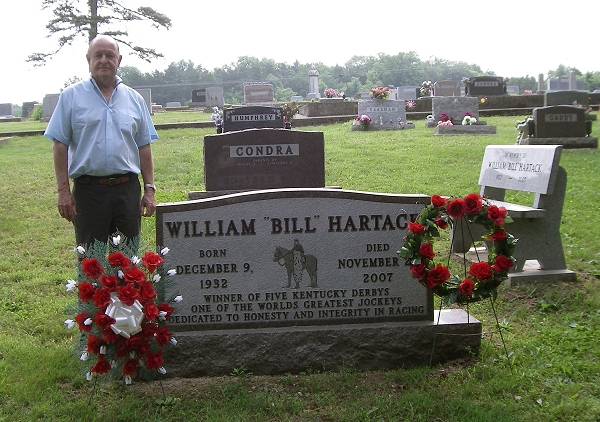
26 Garrett Condra - Bill Hartack Tombstone
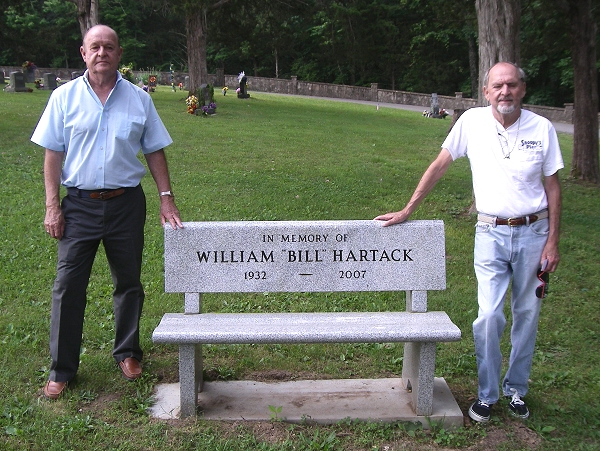
27 Garrett and Roger Condra by Memorial Bench Garrett said that the National Museum of Racing and Hall of Fame places a wreath of roses on Bill’s grave every year on the day of the Kentucky Derby. You can read more about Bill Hartack at the organization’s website.
The Condra family home is still standing on Highway EE just a mile west of Iberia and is located on one of Missouri’s Century farms. The Condra family meets every year there on the Memorial Day weekend. Garrett and Roger’s sister, Louella, attended Iberia Academy with my Aunt Bonnie Bear Tyler and they through the years have maintained a close relationship. However, I had never met Garrett or Roger before although I knew their uncles Wes and Everett Condra. Wes was the barber in Tuscumbia for many years and Everett owned and operated the service station at the intersection of Highways 52 and 17 in Tuscumbia.
I certainly did not know until just recently that Garrett Condra of Iberia, Missouri was the one who had befriended the famous jockey Bill Hartack, who at death had no close relatives, and so kindly arranged for his burial in one of Garrett’s plots at the Iberia Cemetery.
Recently, Tom and Maria Berendzen of Clearwater, Florida visited us at the museum (photo 28).
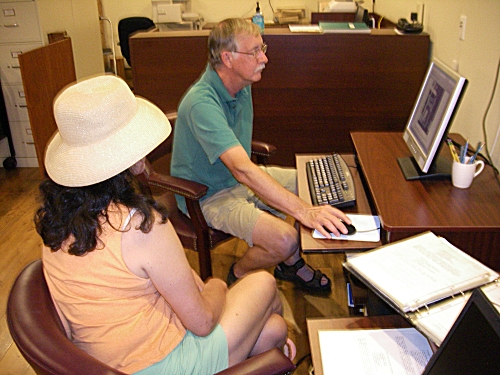
28 Tom and Maria Berendzen - Clearwater, Florida Tom’s sisters had donated to our museum in October of last year a lithographic image of the old Schell Store in Mary’s Home which their parents, Clem and Martha Berendzen, had owned and managed from 1959 until 1975. You can read about the Berendzen family of Mary’s Home at this previous Progress Notes.
Tom and Maria had a delightful time reading the story we put on our internet site about his Berendzen family as shown in the photo. One piece of information I learned from Tom was that his grandfather, William Berendzen, had come to Mary’s Home by following the Osage River upstream in the mid 1800’s. He was from Germany and spoke little English. His son, Clem, Tom’s father, was bilingual although he usually only spoke German when in private conversation with Tom’s mother. Tom said that William was the first Berendzen to come to the area, and that any Berendzen we find in Miller County and mid Missouri is one of William’s descendents. After finishing school at Mary’s Home and Eugene in the 1960’s Tom earned an engineering degree at what was then known as the Rolla School of Mines after which he spent time in Minnesota before moving to Florida.
Quite a few visitors are not aware of our website and it is always a pleasure to have the opportunity to bring up for them on our museum computer articles and photos about their families which they can read and view.
That’s all for this week.
 Joe Pryor
Previous article links are in a dropdown menu at the top of all of the pages.
|

